How the Democrats Can Use Moral Foundations Theory Against Trump
Tom Edsall of the New York Times just published a column giving responses from me and other professors and political strategists to this question: Given the many claims and promises Donald Trump has made which will be impossible to fulfill, how should the Democrats refute them? (E.g., Trump’s claim that he would grow the economy by 6% per year, or end birthright citizenship.) Edsall printed the best parts of my response, but as long as I have a blog where I can post my entire response, here it is:
Hi Tom,
Your question presupposes that the Democrats should be trying to create better arguments. Yes, they should, but that is not the place to start. One of the basic principles of psychology is that the mind is divided into parts that sometimes conflict, like a small rider (conscious verbal reasoning) sitting atop a large elephant (the other 98% of mental processes, which are automatic and intuitive). The elephant is much stronger, and is quite smart in its own way. If the elephant wants to walk to the right, it’s going to, and there’s no point in trying to persuade the rider to steer to the left. In fact, the elephant really runs the show, and the rider’s job is really to help the elephant get where it wants to go. This is why all of us are so brilliant at finding post-hoc justifications for whatever we want to believe. And this is why, in matters of politics and morality, you must speak to the elephant first. Trump did this brilliantly in the Republican primary, and in his convention speech. But how will he do when he appeals to people in the broader electorate?
I think the Democrats need to tell a story about Trump that activates deep and powerful moral intuitions, so that vast numbers of voters find their elephants moving away from Trump. At that point, good arguments will stick.
I think there are two main approaches. The first links to deep moral intuitions about fairness versus cheating and exploitation. Trump presents himself as a successful businessman. But a good businessman creates positive-sum interactions. He leaves a long trail of satisfied customers who want to buy from him again, and a long trail of satisfied partners who want to work with him again. Trump has not done this. He thinks about everything as a zero sum interaction, which he usually wins — and therefore the person who dealt with him loses. I think the Democrats should give voice to a long parade of people — former customers and partners — who deeply regret dealing with Trump. Trump cheats, exploits, deceives. Trump is a con-man, and we are his biggest mark yet. Don’t let him turn us all into suckers.
The second approach is to link to moral intuitions about loyalty, authority, and sanctity. These are the moral foundations that authoritarians and ultra-nationalists generally appeal to, and Trump sure did this in his convention speech. But these can be turned against him too. Trump talks about patriotism (a form of loyalty), but he seems to be pals with one of our main adversaries (Putin) while telling our friends in the Baltics that we may not defend them. In these ways he brings shame to America and weakens our stature among our friends. The moral importance of authority is in part that it creates order, and Trump talks a great deal about law and order, yet he is the chaos candidate who will throw America into constant constitutional crises, throw the world into recession, and throw our alliances into disarray. The moral importance of sanctity is that it brings dignity and exaltation to people, places, and institutions that can unite people who worship things in common. The psychology of sacredness evolved as part of our religious nature, but people use the same psychology toward kings, the constitution, national heroes, and, to a decreasing degree, to the American presidency. Trump degrades it all with his crassness, his obscene language, his fear-mongering and his inability to offer soaring rhetoric. What a contrast with Washington, Jefferson, Lincoln, and Reagan.
So I don’t think the Democrats should focus on raising doubts about his specific promises at this point. They should focus on linking Trump to violations of deeply held moral intuitions. If they can first speak persuasively to voters’ elephants, they will then find it much easier to speak to the reason-based riders, and to raise doubts about the specific things Trump has promised.
Read MoreThe politics of disgust animated for the age of Trump
How does disgust influence modern political behavior? I’ve been studying disgust as a moral emotion since I was a graduate student at the University of Pennsylvania, working with Paul Rozin. It’s a fascinating emotion, lurking behind most of the divisive social issues in the American culture war, from abortion through flag burning, gay marriage, and now trans-gender bathroom access. My colleagues and I have found that social conservatives are higher on “disgust sensitivity” than are progressives and libertarians, and we’ve found that people’s scores on the “sanctity” foundation of the Moral Foundations Scale is a powerful predictor of their attitudes on many political issues, even after you partial out their self-placement on the left-right dimension.
The role of disgust in politics is especially important in 2016 as Donald Trump talks more about disgust than any major political figure since, well, some 20th century figures that were concerned about guarding the purity of their nation and ethnic stock. Studying disgust can help you understand Donald Trump and some portion of his political appeal. I haven’t studied European right-wing movements, but I’ve seen hints that disgust plays a role in many of them as well. Anyone interested in the psychology of authoritarianism should learn a bit about disgust.
In 2013 I gave a talk on the psychology of disgust and politics at the Museum of Sex, in New York City, hosted by Reason, so the audience was mostly composed of libertarians. An artist, Matthew Drake, has just taken a portion of that talk – on the evolution of disgust and its links to politics – and animated it using the RSA whiteboard technique. I think he did a great job; see for yourself below.
(Note that there is no sound for the first 28 seconds)
Read More
The Moral Foundations of the Presidential Primaries
[This guest post was written by Emily Ekins]
We recently published an essay at Vox titled The Moral Foundations of the 2016 Presidential Primaries. That essay was written for a non-academic audience. In this post we expand on our analyses, detail our methodology, and present expanded graphs and data. Please read that essay first, and see the appendix at the end, which lists the 15 questions we used to assess the various moral foundations.
In this post we present:
1) An expanded Figure 1 for all candidates who received support from more than 35 respondents in the sample[1]
2) An expanded analysis of the Democratic race, showing a version of figure 1 for Democratic voters only, which breaks out Authority, Loyalty, and Sanctity as separate bars (Figure 1-D)
3) An expanded analysis of the Republican race, showing a version of figure 1 for Republican voters only, which breaks out Authority, Loyalty, and Sanctity as separate bars (Figure 1-R)
4) Details about our LOGIT regressions (Table 1-D and Table 1-R)
5) Responses to any questions that come up in response to the Vox essay.
1) Expanded Figure 1 for all candidates
Figure 1(a) shows the top Democratic and Republican candidate vote getters, ordered from left to right according to their supporters’ average reported ideology.
Figure 1(a)
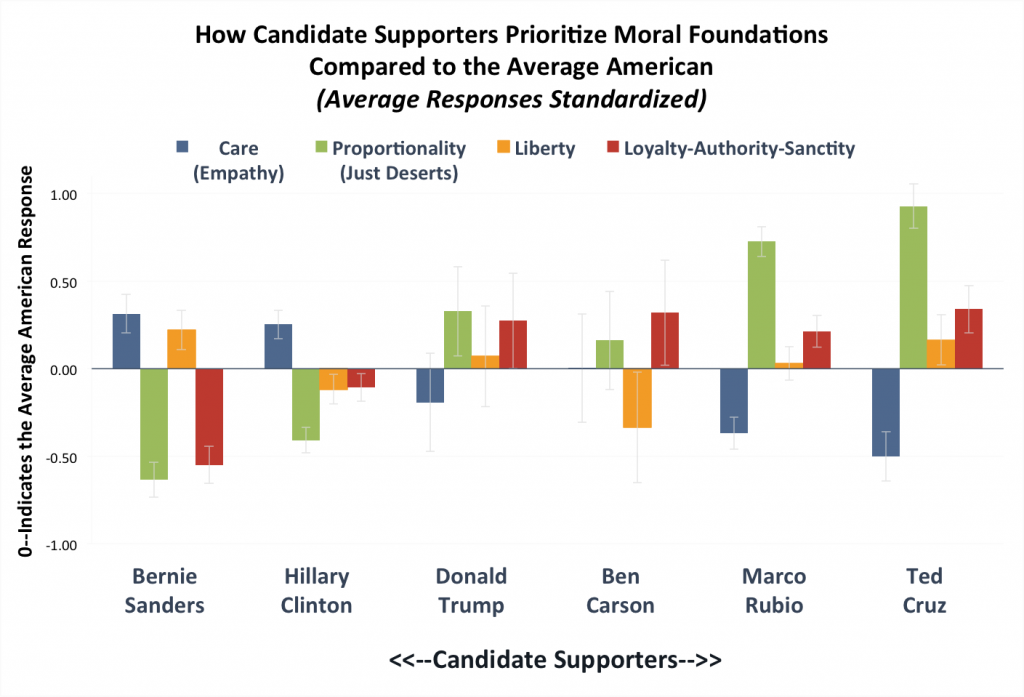
Note: Figure 1(a) reports standardized responses (z-scores), which show how each candidates’ supporters responded to questions about each moral foundation compared to the average American. Y-axis is in standard deviations from the mean. Error bars show 95 percent confidence intervals around the means.
Figure 1(b) shows the 2nd tier candidates also ordered from left to right according to their supporters average reported ideology.
Figure 1(b)
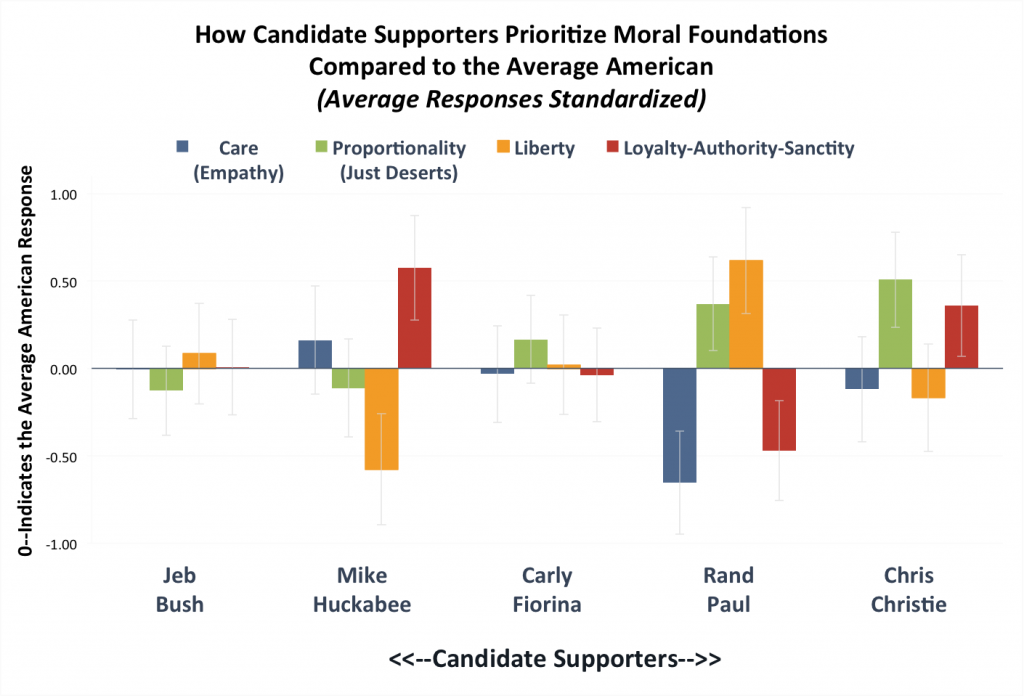
Note: Figure 1(b) reports standardized responses (z-scores), which show how each candidates’ supporters responded to questions about each moral foundation compared to the average American. Y-axis is in standard deviations from the mean. Error bars show 95 percent confidence intervals around the means.
2) An expanded analysis of the Democratic race
The analyses we presented in our Vox essay examined each candidate’s supporters compared to the average American. But these candidates are competing to win over their respective parties’ median voters in the primaries and caucuses. So in this post we zoom in on each party separately. How do each candidate’s supporters compare to the average Republican or average Democrat?
Here we re-standardized each foundation scale among just Democrats. Thus each foundation scale has a mean of 0 and a standard deviation of 1, in which 0 represents the average Democrat in our sample. Then for each Democratic candidate’s supporters, we graphed the average standardized response for each of the six moral foundations.
In Figure 1-D below we show how each Democratic candidate’s supporters prioritize the moral foundations compared to the average Democrat. This means that bars above (or below) zero indicate that Sanders or Clinton supporters place more (or less) emphasis on that moral foundation compared to the average Democrat. Here we break out the Authority, Loyalty, and Sanctity foundations separately to get a more granular picture.
Figure 1-D
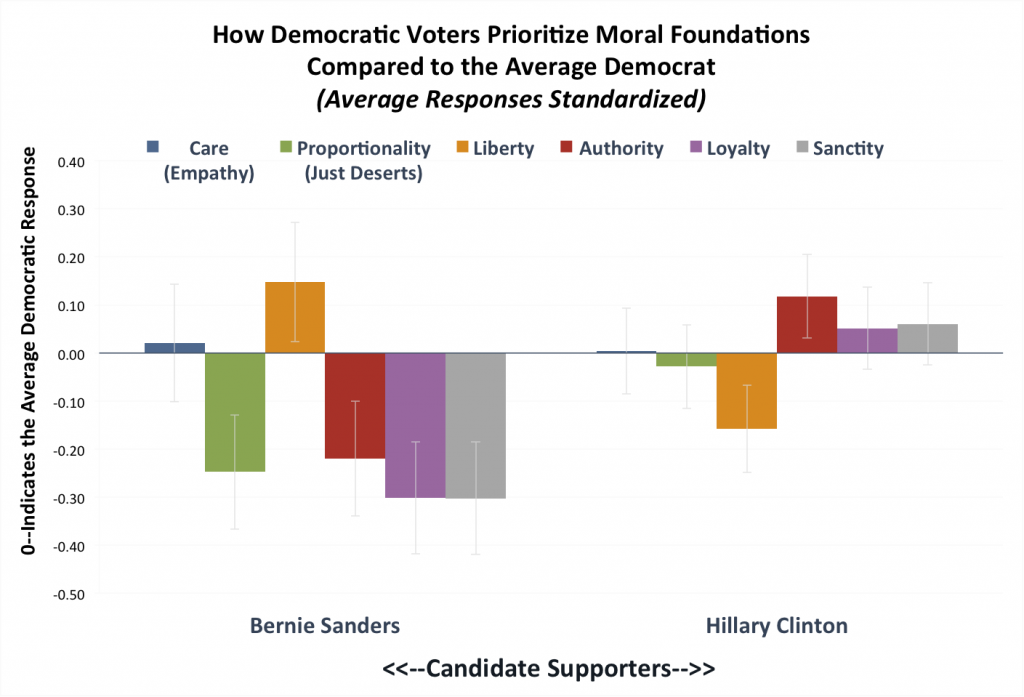
Note: This chart reports standardized responses (z-scores), which show how each candidates’ supporters responded to questions about each moral foundation compared to the average Democrat. Y-axis is in standard deviations from the mean. Error bars show 95 percent confidence intervals around the means.
Supporters of Hillary Clinton and Bernie Sanders do not differ on the Care foundation. Both candidates are progressives who prioritize concerns over those who are suffering. Beyond that Sanders and Clinton supporters diverge.
Sanders draws those with a more libertarian profile, prioritizing concerns about personal freedom and eschewing the socially conservative foundations. Clinton supporters tend to draw from a (relatively speaking) more conservative profile. In some ways, 2016 looks a lot like 2008. Political scientists Marc Hetherington and Jonathan Weiler found that while Clinton and Obama’s voting records were essentially “ideologically indistinguishable,” Clinton managed to attract more authoritarian-leaning Democrats while Obama attracted liberals concerned with individual autonomy. In both the 2008 and 2016 campaigns, Clinton has exuded an image of toughness, often characterizing herself as a “fighter.” She voted for the Iraq War in 2003, has supported greater US involvement fighting ISIS and training Syrian rebels, and keeping troops in Afghanistan, while Sanders opposed the war and these interventions. In fact, Terry Michael writing for the libertarian Reason magazine even declared that compared to Hillary Clinton, “Sanders looks downright Ayn Rand-ish.”
Sanders supporters also stands apart from Clinton’s supporters (and libertarians), in rating proportionality much less relevant to their moral judgments. This aligns with Sanders’ proposing greater expansions of government social welfare programs and higher taxes on the wealthy in comparison to Clinton.
3) An expanded analysis of the Republican race
Next we turn to the top four vote getters in the Republican primaries: Donald Trump, Ted Cruz, Marco Rubio, and Ben Carson. How do their supporters compare with the average Republican voter?
To examine this, we re-standardized each foundation scale among just Republicans. Thus each foundation scale has a mean of 0 and a standard deviation of 1, in which 0 represents the average Republican in our sample. Then for each Republican candidate’s supporters, we graphed the average standardized response for each of the six moral foundations.
In Figure 1-R below we show how each Republican candidate’s supporters prioritize each of the moral foundations compared to the average Republican. This means that bars above (or below) zero indicate the candidate’s supporters place more (or less) emphasis on that moral foundation compared to the average Republican. Here we also break out the Authority, Loyalty, and Sanctity foundations.
Figure 1-R

Note: This chart reports standardized responses (z-scores), which show how each candidates’ supporters responded to questions about each moral foundation compared to the average Republican. Y-axis is in standard deviations from the mean. Error bars show 95 percent confidence intervals around the means.
Notably, the two candidates catapulted to public office by the tea party movement—Marco Rubio and Ted Cruz—stand out because of their supporters’ high endorsement of proportionality. These candidates have drawn in the fiscally conservative wing of the GOP that wants people to be rewarded in prorportion of their achievements, and punished in proportion to their failings. Both sets of supporters also score relatively low on on the Care foundation. When it comes to government adjudicating between justice and mercy, these voters opt for justice. This may be why David Brooks has called Cruz “brutal” while Rush Limbaugh described him as principled and consistent.
These results also highlight the rift between Rubio and the remaining top contenders. Rubio draws the more secular or centrist supporters (indicated by lower purple and grey bars on Loyalty and Sanctity) while Cruz, and Trump attract more religious and culturally conservative supporters. While both Cruz and Rubio have heavily courted key evangelicals for endorsements, Cruz has taken the lead, as some religious leaders express skepticism of Rubio’s financial backers who support gay rights.
These moral differences among supporters also map onto to policy differences of the candidates: For instance, Marco Rubio has sought to liberalize immigration rules while Ted Cruz has promised to oppose a pathway to citizenship for unauthorized immigrants “today, tomorrow, forever” and Donald Trump has gone even further promising to deport every undocumented immigrant.
Ben Carson stands out as the candidate with more empathetic voters, those who score higher on the Care foundation. This may reflect Carson’s warmer style and refusal to engage his opponents in what he calls the “politics of personal destruction.”
One of the biggest surprises in our dataset was that Donald Trump’s supporters did not appear particularly unusual. Part of this is due to the fact that his higher vote share means his supporters are closer to average. However, his supporters do significantly deviate from the average Republican voter in placing greater weight on the Authority/Loyalty/Sanctity composite variable.
4) Details about our LOGIT regressions
To find out if moral foundations improves predicting vote choice we performed a series of regression analyses, one for each presidential candidate. We carried out Logit regressions separately for the Democratic candidates among Democratic respondents, and Republican candidates among Republican respondents.
In order to see if adding the moral foundations improved prediction above and beyond the demographic factors that are usually used, we ran three different models per candidate:
- Model 1 (Column A): This model examines how well self-reported ideology (liberal to conservative) and the standard set of demographic variables predict vote choice.
- Model 2: (Column B): This model examines how well each moral foundation[2] predicts voting for each candidate, while controlling for the effects of the other moral foundations, but without accounting for the effects of demographics and self-reported ideology.
- Model 3: (Column C): This model combines Model 1 and 2 to examine how well each moral foundation predicts vote choice, while also accounting for the effects of demographics, self-described ideology, as well as the other moral foundations.
First we report results that predict voting for a Democratic candidate among Democrats in Table 1-D:
Democratic Primary
Table 1-D
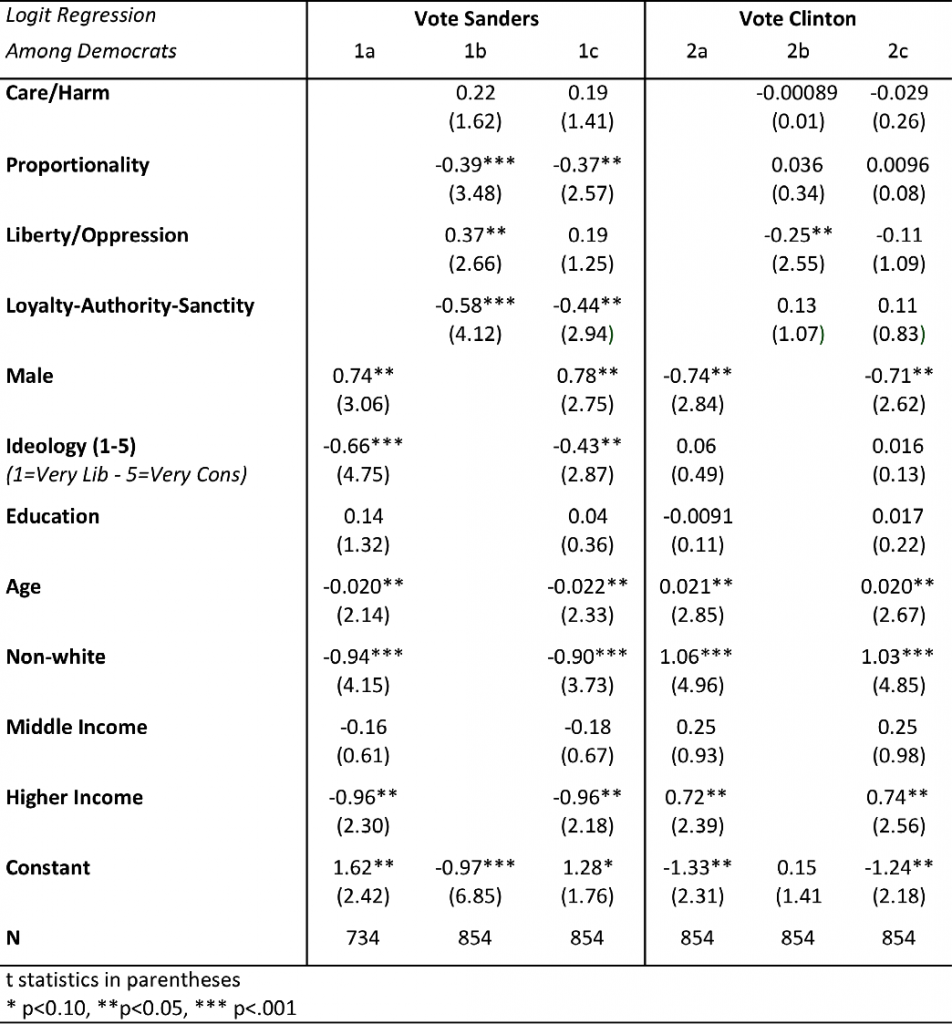
Note: Logit regression conducted among Democrats only, results report standardized betas, t statistics in parentheses, clustered standard errors by state.
Before controlling for demographic factors, the Liberty foundation significantly predicts a vote for Sanders and a vote against Clinton among Democrats. However, young white civil libertarians seem to largely be driving this effect. Once age and race are included in the analysis, the Liberty foundation no longer predicts voting for Bernie Sanders. When accounting for demographics, Sanders is negatively predicted by Proportionality and Authority/Loyalty/Sanctity. The moral foundations do not significantly predict a vote for Hillary Clinton, after controlling for background and ideology among Democrats.
Second we report results that predict voting for a Republican candidate among Republicans. We first present logit regression results for the top four Republican vote getters shown in Table 1-R(a). Candidates are ordered from left to right according to their respondents’ average reported ideology.
Republican Primary
Table 1-R(a)
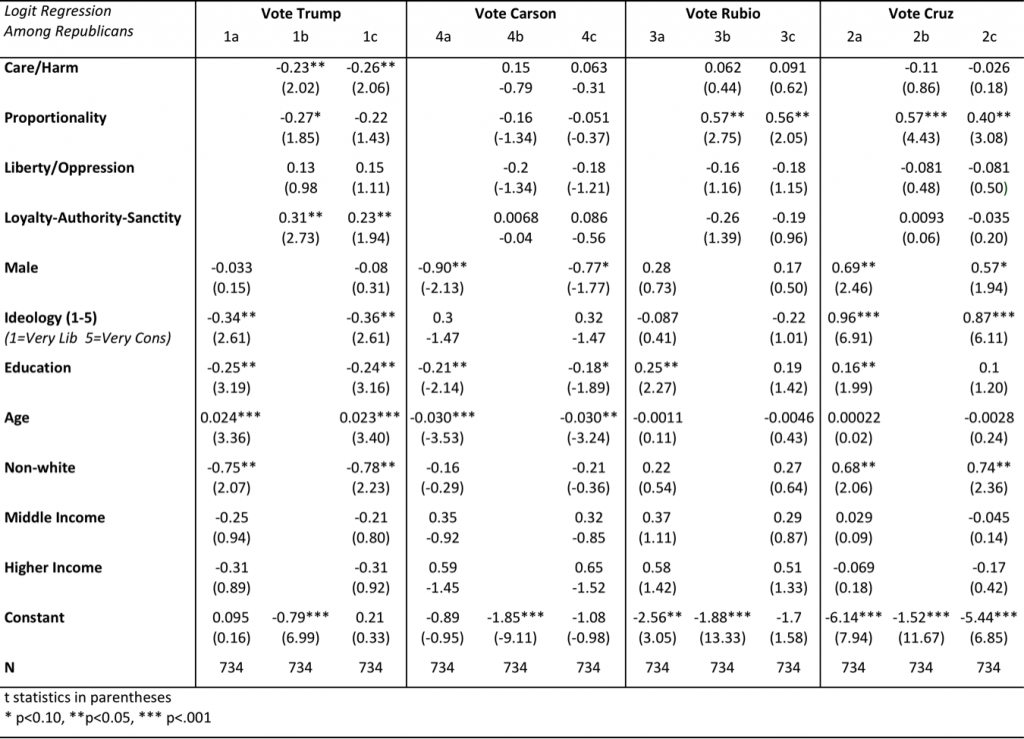
Note: Logit regression conducted among Republicans only, results report standardized betas, t statistics in parentheses, clustered standard errors by state.
Next we present logit regression results for the remaining Republican candidates shown in Table 1-R(b). Candidates are ordered from left to right according to their respondents’ average reported ideology.
Table 1-R(b)
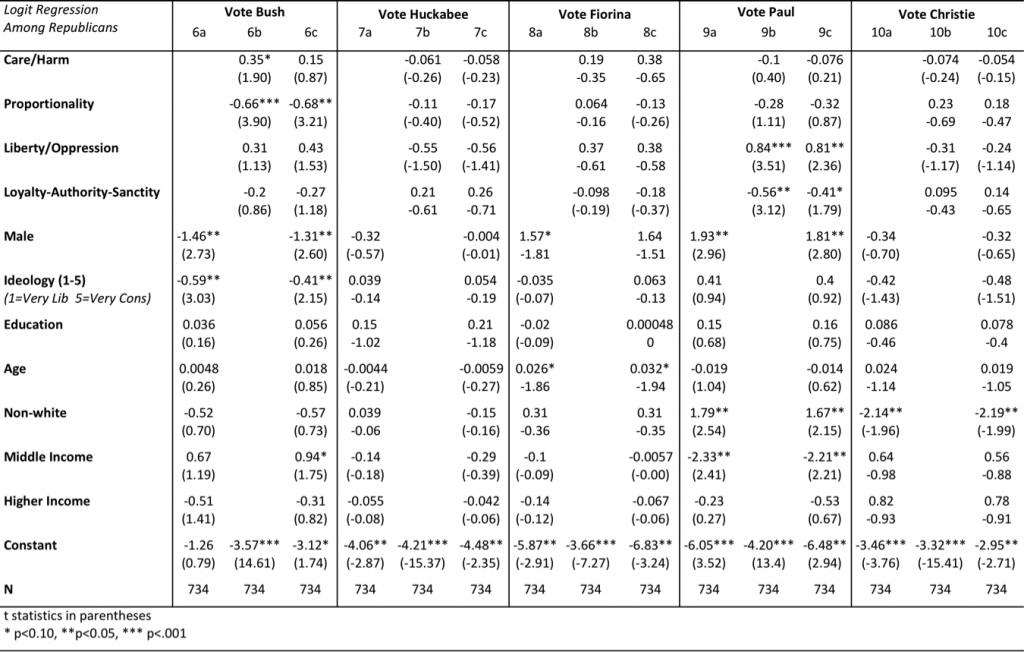
Note: Logit regression conducted among Republicans only, results report standardized betas, t statistics in parentheses, clustered standard errors by state.
Among Republicans, the moral foundations significantly predicted vote choice for Donald Trump, Ted Cruz, Marco Rubio, Jeb Bush, and Rand Paul, but not for Mike Huckabee, Ben Carson, Carly Fiorina, or Chris Christie.
We find the Authority/Loyalty/Sanctity foundation is significantly predictive of voting for Donald Trump, but none of the other GOP candidates. The Care foundation significantly predicts voting against Trump. This pattern is consistent with claims that Trump attracts authoritarians. Proportionality significantly predicts support for Cruz and Rubio even when controlling for ideology and demographics. These candidates draw the fiscal conservatives who want society to reward people according to what they have earned, not according to their needs. However, in contrast to Cruz and Rubio, Proportionality predicts voting against Jeb Bush. Instead Bush attracts Republicans who are less focused on enforcing proportional fairness in society. High ratings on the Liberty foundation significantly predict a vote for Rand Paul while the Authority/Loyalty/Sanctity foundation negatively predicts it. Rand Paul draws the libertarian vote but has projected a rather narrow moral appeal.
4) Responses to any questions that come up in response to the Vox essay.
[We will post responses here as questions or criticisms arise. Please send questions to eekins at cato.org]
Updated 4/6/2016: Response to commenter Betsy: Because Trump has a larger share of the vote, his supporters’ standardized scores for each moral foundation are more likely to be closer to average. Since 0 indicates the median voter, candidates with larger vote shares will appear closer to average. However, Jeb Bush who had only about 4% of the vote also had supporters who are close to the national average. Table 1-R(a) shows that Trump is the only Republican candidate significantly positively predicted in a multivariate regression by the Loyalty-Authority-Sanctity foundation and negatively predicted by the Care/Harm foundation. While not all Trump supporters fit the profile of a voter who scores low on compassion and high on respect for authority, a considerable share do. Another method to investigate your question is to conduct cluster analyses of Trump supporters. We have done some preliminary tests finding roughly 2-3 groups. One group scores particularly high on Loyalty-Authority-Sanctity, while another group appears to be less engaged and scores lower on all the foundations. When these different groups are averaged together, the average Trump supporter is closer to the average.
Regarding model fit, Wald Tests reveal that adding moral foundation variables often does significantly improve model fit. For instance for Bernie Sanders Wald=17.70 p < .001, or for Donald Trump Wald=11.14 p <.05, for Ted Cruz Wald=14.01 p < .01. However, it does not for Hillary Clinton. As we have shown, for several candidates the moral foundations were significantly predictive of vote choice. Table 1-D should address the logit model you suggest. This regression is run among Democratic voters only and predicts voting for Sanders or Clinton respectively among Democratic voters.
Footnotes
[1] The survey included oversamples of African-Americans, Hispanics, and Tea Party supporters. We apply weights throughout our analyses.
[2] Since Authority, Loyalty, and Sanctity are moderately intercorrelated, we included the composite variable in the regression.
Read More